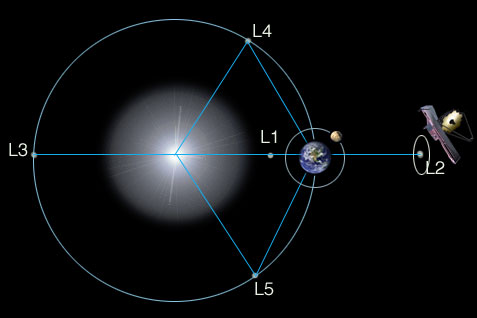
Posted on 12/25/2021 11:37:59 AM PST by Fractal Trader

So the space around Earth is warmer?
—
L2 places the Earth between the Sun and the telescope so the telescope will be in perpetual darkness. Apparently any sunlight falling on the telescope would disrupt its ability to gather light in the infrared.
A lunar eclipse puts the earth between the sun and moon, but the moon is NOT blocked from all the sun light as it only turns dark red from sunlight passing thru earth atmosphere.
The Webb will oscillate around the L2 as the Moon orbits the earth. This will put the satellite in view of the sun - thus the need for the intricate sun shield.
The 32 minute video was very informative.
I hear there is a Chicken House down in Texas, which would qualify as a LaGrange Pt.
Kevmo: It would be a fascinating mission to punch into an asteroid and then let that asteroid carry the camera to the outer parts of the solar system.
Elsie: Punch?
Wouldn’t a gentle landing be required?
And a soft landing means the speeds are almost identical.
Therefore no asteroid would be needed to ‘carry’ it anywhere.
***When you reach the apogee, you’re out of fuel for the most part. But that asteroid is going full blast around the earth and other planets. By lodging into the asteroid you harness its kinetic energy.
If we like to or not science keeps moving on, and most of us keep moving right along with it. Many humans have an inquisitive mind which is not easily satisfied, without it we still would not be where we are today.
I forgot. You’re correct, it orbits around L2, which is kind of weird as it is orbiting nothing.
Lodging?
How many negative Gs would that create?
I think a telescope this complex is fairly delicate.
So true.
My wife just calls me very nosy.
... it is orbiting nothing.
It is actually ‘orbiting’ the Sun, but held in place by opposing gravitational forces, kinda like THESE guys, that are suspended between two forces: gravity and magnetism.
https://duckduckgo.com/?q=magnetically+suspended+globe&iax=images&ia=images
Or gravity & air pressure...
https://duckduckgo.com/?q=ping+pong+ball+balanced+on++air+hair+dryer&iar=images&iax=images&ia=images
How many negative Gs would that create?
***Probably about the same number as the 2 Mars rovers experienced when they balloon-bounced onto that planet.
What I’m proposing has already been done, I just think we should send sumthin that lasts longer than 16 days.
https://www.quora.com/search?q=landing%20probe%20on%20asteroid
Have we ever landed on an asteroid?
Profile photo for David Goodman
David Goodman
·
Follow
4y
Have we ever landed on an asteroid?
There have been 2 occasions so far that unmanned human-made spacecraft have landed on asteroids:
On February 12, 2001 the asteroid Eros was landed on by the USA NEAR Shoemaker mission which was designed as an orbiter but was gently maneuvered into Eros until it lay on the surface. The probe continued to transmit for 16 days after landing.
November 2005, the Japanese Hayabusa probe twice “landed” on the asteroid Itokawa. Perhaps “brushed” is a better description than landed because the probe skimmed the asteroid for a few seconds collecting a small amount of dust and carried out its sample return mission, sending the sample back to Earth in a small reentry capsule.
NEAR Shoemaker probe set down on Eros (artist’s conception):
I’m not suggesting that we couldn’t land on one, just that the words PUNCH or LODGE seem fairly high impact to me.
Disclaimer: Opinions posted on Free Republic are those of the individual posters and do not necessarily represent the opinion of Free Republic or its management. All materials posted herein are protected by copyright law and the exemption for fair use of copyrighted works.